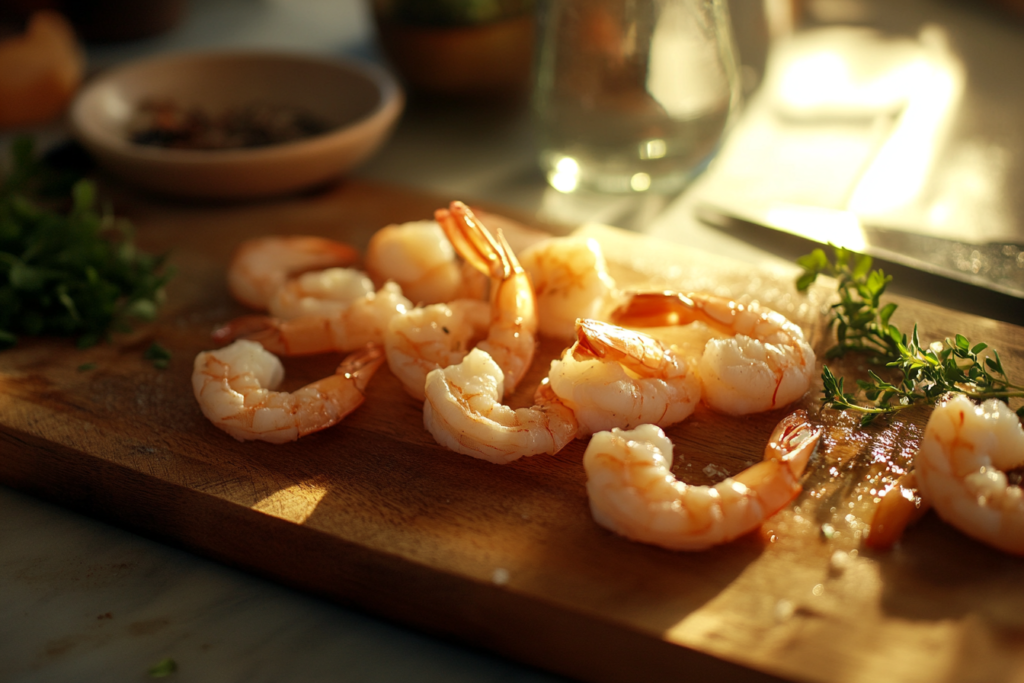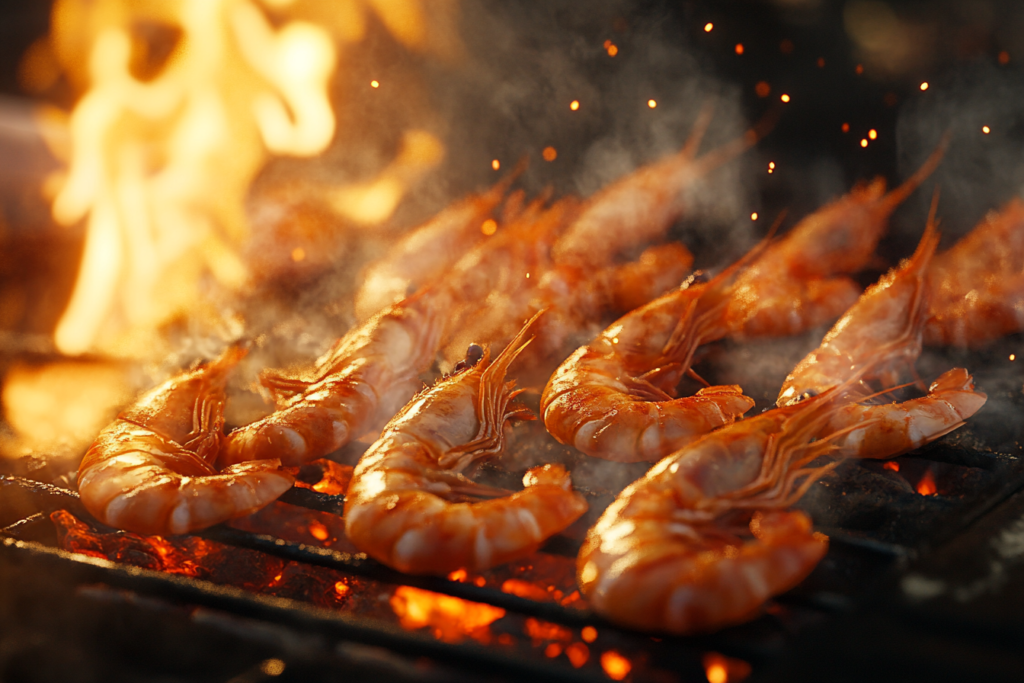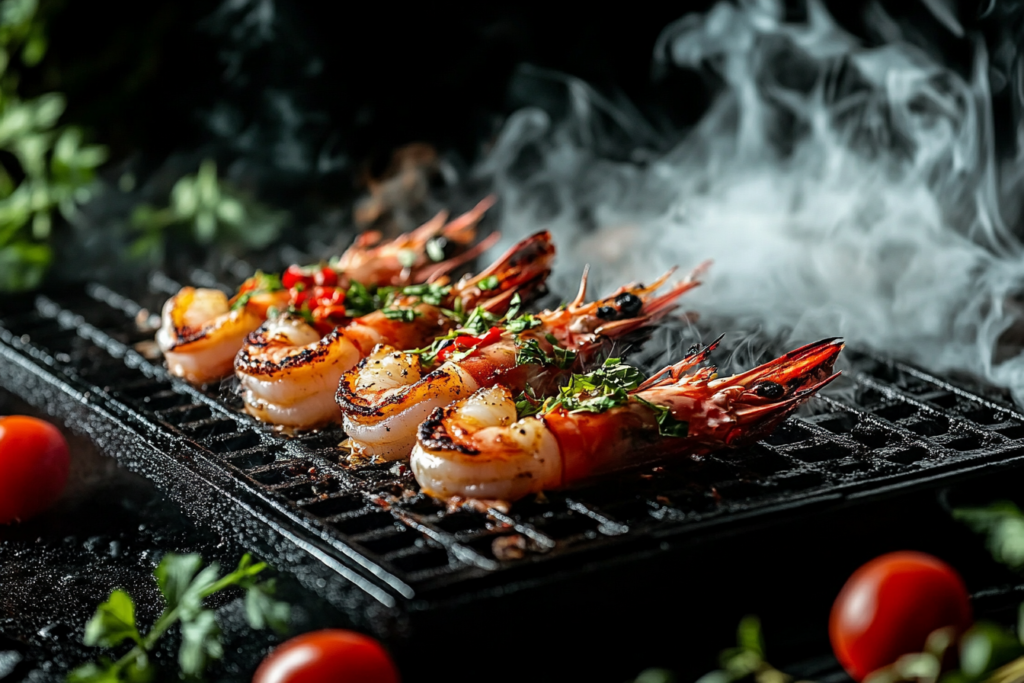Introduction to Barbecuing Shrimp
What Makes Shrimp a Popular Choice for Barbecuing?
Barbecuing shrimp is a favorite among seafood lovers, but a common question arises: Is it better to barbecue shrimp with shell on or off? This simple decision can drastically affect the flavor, texture, and overall experience of your meal. By understanding the pros and cons of both methods, you can make an informed choice to suit your taste and style of cooking. Let’s dive into the details to find out which method works best for you!
Why the Debate: Shell On vs. Shell Off?
One of the most debated topics among seafood enthusiasts is whether shrimp should be grilled with the shell on or off. Each method has its merits, impacting flavor, texture, and preparation ease. Understanding these differences can elevate your barbecuing experience. So, is it better to barbecue shrimp with shell on or off? Let’s explore.
Understanding the Basics of Shrimp Preparation
Types of Shrimp Suitable for Barbecuing
Various shrimp species are suitable for grilling, including tiger shrimp, white shrimp, and pink shrimp. Larger varieties, such as jumbo or colossal shrimp, are often preferred as they are less likely to overcook and provide a meatier bite.
When choosing shrimp, look for ones that are fresh or flash-frozen. Fresh shrimp should have a clean, briny scent — anything overly fishy is a no-go. If you’re buying frozen, opt for ones labeled “deveined” to save yourself some prep time.

Pre-Barbecue Preparation: Cleaning and Deveining Shrimp
Proper cleaning and deveining are essential, regardless of whether you keep the shell on or off. Removing the vein ensures a cleaner taste and better presentation. Rinse the shrimp thoroughly and pat dry before marinating.
Should you keep the tail on or off? This depends on personal preference. Tails can serve as a built-in handle for eating but aren’t necessary if you’re serving them in a dish.
Shell On vs. Shell Off: What’s the Difference?
The shell acts as a protective barrier, influencing how the shrimp cooks and tastes. Removing the shell allows marinades to penetrate directly but may result in quicker drying. In contrast, shell-on shrimp retain moisture and develop a smoky flavor from the grill. Is it better to barbecue shrimp with shell on or off? It depends on your preferences and the outcome you’re aiming for.
The Science Behind Shrimp Shells and Barbecuing
How Shells Affect Shrimp Texture and Flavor
The shell traps heat and moisture, creating a steaming effect that keeps the shrimp tender. It also imparts a slightly smoky, charred flavor when exposed to direct grill heat. When asking, “Is it better to barbecue shrimp with shell on or off?”, consider how much flavor and texture matter to you.
The Role of Shells in Retaining Moisture During Grilling
Shells prevent moisture loss, a common issue when grilling shrimp. This makes them an excellent choice for high-heat cooking methods. This is another key point to consider when deciding, “Is it better to barbecue shrimp with shell on or off?”
Does Shell Removal Impact Marination?
Shell-off shrimp absorb marinades more effectively, enhancing flavor depth. However, shell-on shrimp can still benefit from marinades if allowed to soak for a longer time. Depending on how much flavor infusion you’re after, this can help answer, “Is it better to barbecue shrimp with shell on or off?”
Benefits of Barbecuing Shrimp with Shell On

Enhanced Smoky Flavor
Barbecuing shrimp with the shell on can transform the grilling experience into something magical. When the shrimp’s shells come into contact with the high heat of the grill, they start to char slightly, creating a smoky aroma and flavor that permeates the meat. This subtle smokiness is something you just can’t replicate with shell-off shrimp. It’s like wrapping a gift — the shell becomes a natural packaging that delivers a flavorful surprise with every bite.
The shells also help trap any seasoning or marinade applied to the outside, allowing it to caramelize beautifully. Think of it as nature’s grilling jacket that locks in the essence of the barbecue. And while the flavors may not soak as deeply into the shrimp meat as they would without the shell, the shell-on method delivers a unique, rustic taste that’s hard to beat.
Protection Against Overcooking
Shrimp are delicate creatures when it comes to cooking. One second too long on the grill, and you’re left with a rubbery disappointment. That’s where the shell truly shines. It acts like a buffer, protecting the tender meat from the grill’s intense heat and helping to evenly distribute the warmth. This insulation keeps the shrimp juicy and prevents it from overcooking too quickly.
Think of the shell as a tiny shield — it might not look like much, but it’s doing some serious work behind the scenes to keep your shrimp succulent. For anyone who’s ever felt the heartbreak of overcooked shrimp, the shell-on method can be a lifesaver.
Better Visual Presentation
Let’s be honest, shrimp look amazing when grilled with their shells on. The shell develops a gorgeous charred pattern, and the bright orange or pink hue of the shrimp itself makes it a show-stopper on any plate. Whether you’re hosting a summer barbecue or preparing a seafood feast, shell-on shrimp have a way of catching the eye.
Presentation matters, especially when serving food to guests. Shell-on shrimp exude a gourmet vibe that suggests effort and attention to detail. Plus, the act of peeling the shrimp can be part of the dining experience, offering a hands-on element that many people find enjoyable — almost like cracking crab legs or peeling a boiled crawfish.
Benefits of Barbecuing Shrimp with Shell Off

Direct Absorption of Marinades
If you’re all about bold, intense flavors, shell-off shrimp is the way to go. With the shells removed, marinades can penetrate directly into the meat, infusing every bite with your chosen seasonings. Whether it’s a zesty lemon-garlic mix or a spicy Cajun rub, the shrimp absorb the marinade like a sponge, resulting in a dish bursting with flavor.
This method is perfect if you want to get creative with your seasonings. Shell-off shrimp act as a blank canvas, soaking in whatever flavors you throw at them. The result? A punchy, flavor-packed bite every time.
Ease of Eating and Serving
There’s something incredibly satisfying about food that’s ready to eat straight off the grill. With shell-off shrimp, there’s no peeling required, making it a more convenient option for casual meals or larger gatherings. Guests can simply grab a skewer or fork and dig in without worrying about sticky fingers.
For dishes where shrimp are mixed with other ingredients, such as pasta or rice, the shell-off method is a no-brainer. It eliminates the extra step of peeling and ensures that every bite is easy and enjoyable.
Faster Cooking Times
Shrimp cook quickly — we’re talking a couple of minutes per side on the grill. Without the shell, this process becomes even faster. Shell-off shrimp respond directly to the heat, making them ideal when you’re pressed for time or trying to manage multiple dishes at once.
This speed doesn’t mean you’re sacrificing quality. In fact, it gives you more control over the cooking process, ensuring that your shrimp are cooked just right. For busy weeknight dinners or spontaneous barbecues, shell-off shrimp are a fantastic option.
Techniques for Barbecuing Shrimp with Shell On
Ideal Heat Settings for Shell-On Shrimp
When grilling shrimp with the shell on, finding the right heat setting is crucial. Medium-high heat is your best friend here. Why? It ensures the shells get that perfect char while the shrimp inside cooks evenly. If the heat is too high, you risk burning the shells before the shrimp is done. Too low, and you won’t get that delightful smokiness that shell-on grilling is known for.
You’ll also want to preheat the grill thoroughly. A hot grill prevents the shrimp from sticking and helps achieve those beautiful grill marks. Aim for about 3–4 minutes per side, depending on the size of the shrimp. The key is to watch for the shrimp to turn opaque and pink.
Using Skewers for Better Handling
Handling shell-on shrimp can be a little tricky, especially when flipping them on the grill. That’s where skewers come to the rescue. Threading shrimp onto skewers not only simplifies grilling but also makes flipping them a breeze. Plus, it keeps the shrimp from falling through the grill grates.
For best results, use flat skewers or thread the shrimp in a way that prevents them from spinning. Wooden skewers should be soaked in water for about 30 minutes beforehand to avoid burning. Metal skewers are also a fantastic, reusable option.
Recommended Sauces and Seasonings
Shell-on shrimp are like a blank canvas for bold and vibrant flavors. Their natural sweetness pairs beautifully with a variety of seasonings and sauces. Garlic butter is a classic go-to — it seeps into the shells and enhances every bite. For something zesty, try a chili-lime marinade. Want a touch of umami? Soy-ginger glazes work wonders.
Pro tip: Brush the shrimp with your sauce or marinade about halfway through grilling. This prevents the sugars in the sauce from burning while giving the flavors enough time to caramelize.
Techniques for Barbecuing Shrimp with Shell Off
Preventing Shrimp from Sticking to the Grill
Shrimp without shells are more prone to sticking to the grill grates. To avoid this culinary catastrophe, make sure your grill grates are clean and lightly oiled. You can use a grill-safe brush or a paper towel dipped in oil to grease the grates before grilling.
Another trick? Use a non-stick grill mat or basket. These tools are especially handy when grilling smaller shrimp that might slip through the grates.
Effective Marinade Recipes
With the shells removed, shrimp soak up marinades like a sponge. The possibilities here are endless! A simple lemon-garlic marinade can bring out the shrimp’s natural flavors, while a spicy Cajun blend adds a bold kick. For something unique, try a coconut-curry marinade for a touch of tropical flair.
Let the shrimp marinate for about 15–30 minutes. Any longer, and the acid in the marinade might start to break down the shrimp, altering its texture.
Tips for Maintaining Juiciness Without Shells
Shell-off shrimp are more vulnerable to drying out, so you’ll need to keep a close eye on the grill. Cook them over medium heat for about 2–3 minutes per side. As soon as the shrimp turn pink and opaque, they’re done. Overcooking even by a minute can turn them rubbery.
Another way to keep them juicy is to baste them with a little melted butter or olive oil while grilling. This adds a layer of moisture and enhances the overall flavor.
Comparative Analysis: Shell On vs. Shell Off
Flavor Differences
When it comes to flavor, it’s a bit of a trade-off. Shell-on shrimp develop a smoky, charred taste from the grill, with the shells acting as a flavor-enhancing barrier. Shell-off shrimp, on the other hand, allow marinades and seasonings to shine through, offering a bolder, more pronounced flavor.
Texture Differences
Texture-wise, shell-on shrimp are juicier because the shells help retain moisture during grilling. Shell-off shrimp, while still tender if cooked properly, can dry out more quickly without that protective layer.
Time and Effort Required
Cooking and eating shrimp with the shell on requires a bit more effort. Guests will need to peel the shrimp before eating, which can be messy. Shell-off shrimp are ready to eat straight off the plate, making them more convenient, especially for larger gatherings.
When preparing to barbecue shrimp, whether you choose shell-on or shell-off, it’s essential to consider how you can elevate the flavor and presentation of your dish. For more detailed insights, check out our guide on the best way to barbecue shrimp for perfect flavor, which offers tips to achieve an ideal balance of smokiness and juiciness. Additionally, learn how to complement your shrimp barbecue with creative ideas from our piece on barbecue shrimp perfect pairings. If you’re looking for a comprehensive step-by-step approach to mastering shrimp on the grill, the BBQ shrimp recipe ultimate guide is a must-read. These resources ensure that your next shrimp barbecue is not only flavorful but also unforgettable.
FAQs About Barbecuing Shrimp
Is it better to grill shrimp with or without the shell?
It depends on what you’re looking for! If you want shrimp that’s juicy and infused with a smoky, charred flavor, grilling with the shell on is the way to go. The shell acts as a barrier, protecting the delicate meat and keeping it moist. On the other hand, grilling without the shell allows marinades and seasonings to penetrate deeply, delivering bold and concentrated flavors. Ultimately, both methods have their strengths, and the “better” option depends on your goals for flavor and convenience.
Do you remove shells from shrimp when grilling?
Removing the shells before grilling is optional and based on personal preference. If you’re aiming for convenience, especially in a party setting, shell-off shrimp are easier to eat and serve. However, leaving the shells on provides extra protection from the grill’s heat, preventing overcooking. Plus, it enhances the smoky flavor and keeps the shrimp juicier. You can even split the difference by leaving the tail on for a nice presentation and easier handling.
Do you cook shrimp with the shell on or off?
Cooking shrimp with the shell on is a great choice if you want to retain moisture and add a smoky, grilled flavor. The shells create a steaming effect, ensuring tender and juicy shrimp. For recipes requiring intense seasoning or marinade flavors, cooking with the shell off may be more effective. Both methods work well, so the choice ultimately depends on your desired outcome and the dining experience you’re aiming to create.
Does cooking shrimp with the shell on give more flavor?
Yes, cooking shrimp with the shell on enhances its natural flavor. The shells char slightly on the grill, adding a subtle smokiness that elevates the shrimp’s taste. Additionally, the shell helps trap the shrimp’s natural juices, keeping it succulent. While the flavors may not soak as deeply as they do with shell-off shrimp, the overall taste is often richer and more complex with the shell intact.
Conclusion: Making the Right Choice
Factors to Consider: Flavor, Texture, and Convenience
Choosing between grilling shrimp with the shell on or off boils down to what matters most to you. If you’re looking for tender, juicy shrimp with a smoky, charred flavor, shell-on is the way to go. The shell acts as a natural protector, locking in moisture and preventing overcooking. However, if you want bold, concentrated flavors from marinades or prefer hassle-free eating, grilling shrimp without the shell is a better option.
Texture is another important factor. Shell-on shrimp retain a juicier, softer texture, while shell-off shrimp tend to have a slightly firmer bite. And of course, convenience plays a role. Shell-on shrimp might require more effort at the table, while shell-off shrimp are ready to eat and easier for guests to enjoy.
Recommendations Based on Cooking Contexts
- Casual Gatherings or Large Parties: Shell-off shrimp are more practical and easier for guests to eat without the mess of peeling.
- Gourmet Meals or Impressing Guests: Shell-on shrimp deliver unbeatable flavor and presentation, making them the star of the show.
- Time-Saving Recipes: Shell-off shrimp cook faster and absorb marinades more effectively, making them ideal for quick dinners.
- Moisture Retention: Shell-on shrimp are the best choice if you’re worried about overcooking or drying them out.
In the end, there’s no definitive right or wrong answer. Both methods have their place in the world of grilling, and your choice will depend on the occasion, your audience, and the flavors you want to achieve. Why not try both and see which one you prefer? Shrimp are versatile enough to let you experiment and have fun!

